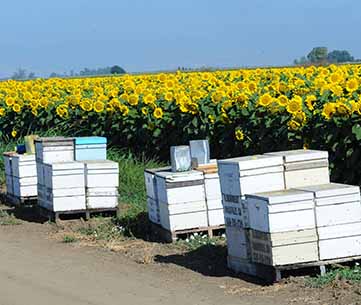Managing the risk of honey bee poisoning
To reduce the risk of honey bee poisoning events occurring, it is important to understand how honey bee poisoning may occur. Honey bee poisoning events may occur in some of the following ways:
- When a chemical is applied directly to a flowering crop while bees are foraging.
- When a chemical is applied to a crop that is flowering and bees subsequently forage on contaminated nectar, pollen or water or alight on a contaminated plant part.
- When a chemical is applied to a crop not in flower, but is also applied to non-target plants that are flowering (eg weeds), at the same time.
- When pesticide drifts onto bees, flowering plants, hives or the bees’ water source.
- When a worker bee carries contaminated nectar, pollen or water back to the hive, contaminating the colony.
- When an areas within the bees’ flight path is sprayed.

Hives of bees pollinating a sunflower field. Kathy Keatley Garvey, UC Davis Department of Agriculture
Management practices for farmers
There are variety of management practices that both farmers and beekeepers can do to reduce the risk of a honey bee poisoning event. For farmers, this includes:
- Reduce the need for chemical use by adopting integrated pest management (IPM) principles where appropriate.
- Contact the owners of any hives in the area well before spraying, so that they have an opportunity to relocate or protect their hives. Also consider owners of hives on adjacent properties, bearing in mind that bees commonly forage within a 5 km radius, sometimes further.
- If using spray contractors, inform them of the location of any hives that may be affected and ensure that they understand the importance of reducing the risk of honeybee poisoning.
- Read and always comply with the chemical product label.
- Choose appropriate spraying conditions so as to avoid the chance of spray drift affecting non-target flowering crops, hives, and water.
- Ensure that bees are not foraging in the target area. This is a condition of some product labels and is therefore a legal requirement. This may include bees from hives located on adjacent properties, and feral bees as well. Remember, poisoning bees reduces future pollination potential.
- Mow flowering weeds inside the target area to reduce the damage to bees that may otherwise forage there.
- Talk to your agronomist and apiarist to help select chemicals that pose a low risk to bees, whilst still achieving the required outcome for your business.
- Download the Pesticide risk management plan and work with the local beekeeper to implement this management plan. This download is an extract from Honeybee pesticide poisoning: a risk management tool for Australian farmers and beekeepers, published by the Rural Industries Research and Development Corporation.
Management practices for beekeepers
Beekeepers can reduce the risk of a honey bee poisoning event by following the below practices:
- Before placing the hives on site, work with the farmer to plan a chemical application program that works for both parties. If the farmer needs to apply chemicals, discuss when this will occur and how the risk can be managed. For example, the hives may be able to be placed on site after chemical application, or removed prior to chemical application.
- Ensure that the farmer and neighbouring landowners have your full contact details so that you can be contacted quickly.
- Notify aerial operators operating in the area. In NSW and Queensland, beekeepers in cotton growing districts can advise aerial operators using the Bee Alert program.
- Advise other nearby land managers, such as local councils.
- Ensure that at least some of your hives are marked, or your apiary is signposted with your contact details (including your mobile phone number) so that other people can contact you urgently if required. Ensure that the lettering is large enough to be read from a distance, as people will not want to move close to hives.
- Select sheltered areas that offer some protection against spray drift. Consider the prevailing wind and seek advice from locals.
- Ensure that bees have access to clean water. Bees require a lot of fresh water, and if it isn’t readily available, they may search further afield and drink chemically contaminated water from flowers and other sources.
- Identify an appropriate area nearby (but at least 3 km away) that hives can be temporarily relocated to if needed.
- Inspect hives regularly so symptoms of bee poisoning can be identified early.
- Relocate hives before bees are forced to forage across a wider area than was originally intended. Bees have been known to forage up to a 12 km away from hives when necessary.
- Download the Pesticide risk management plan and work with the local farmer to implement this management plan. This download is an extract from Honeybee pesticide poisoning: a risk management tool for Australian farmers and beekeepers, published by the Rural Industries Research and Development Corporation.
References
The information on pesticides toxic to honey bees is summarised from Daryl Connelly (2012) Honey bee pesticide poisoning – a risk management tool for Australian farmers and beekeepers, Rural Industries Research and Development Corporation Publication 12/043.

